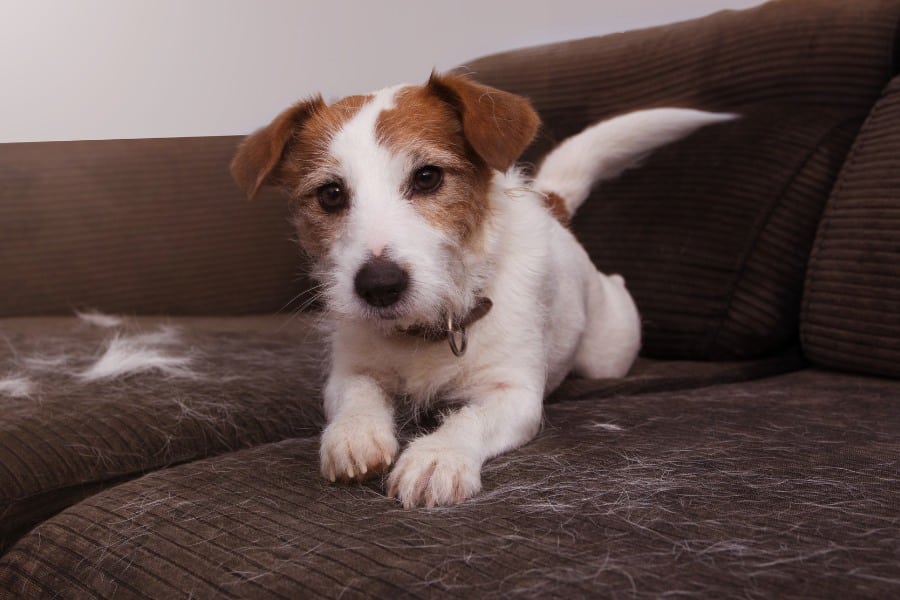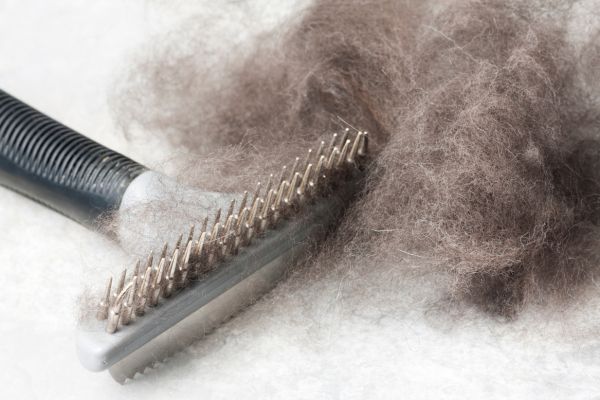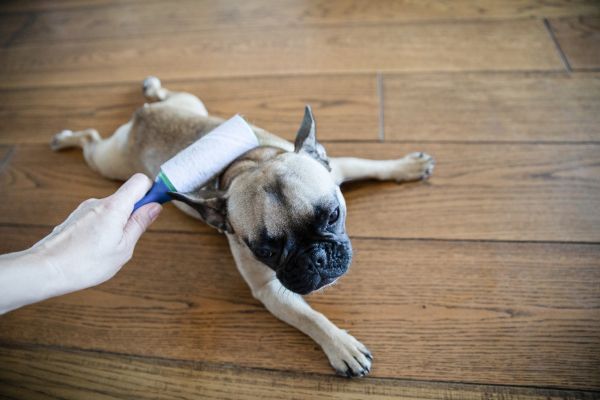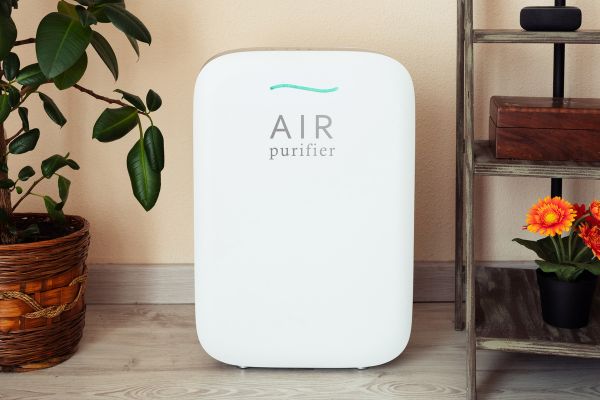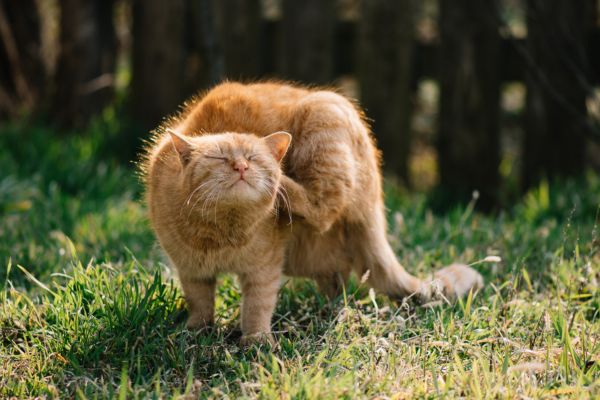You’re heading into an important meeting and are dressed for success. You glance down to make sure all buttons and zippers are in place and notice that your clothes are sprouting pet fur. You frantically pick at the tiny spikes. Where’s a lint roller when you need one?
Pet parenting can seem like a constant battle against tiny hairs that embed themselves in every crevice of your clothing and furniture, not to mention tumbleweeds of fur that perpetually roll across the floor.
While shedding is a nuisance, it’s also a natural and important part of your pet’s health.
Why Our Furry Friends Cast Off Their Coats
Just like us, dogs and cats shed because their hair follows a natural growth cycle that typically consists of three phases:
- Anagen: The active growth phase where new hair follicles produce hair.
- Catagen: A transitional phase where hair growth slows down and the hair follicle detaches from the blood supply.
- Telogen: The resting phase where the hair is finally shed and the follicle prepares for a new hair to grow.
The entire cycle can take weeks or even months, and the shedding you see is simply the accumulated dead hair from this process.
Seasonal Shedding: Adapting to the Weather
All cats and dogs shed to some degree throughout the year. Shedding helps remove dead and damaged hair, keeps your pet’s coat healthy, and promotes the growth of new fur.
But shedding is often more noticeable during specific times.
Dogs with double coats, like Huskies and Golden Retrievers, shed heavily twice a year – in the spring and fall. This “blowout” helps them regulate their body temperature.
Spring shedding gets rid of the thick undercoat so they can stay cool in the warmer months, while fall shedding prepares them for growing a thicker winter coat.
Heavy Shedders vs. Low Shedders: Breed Breakdown
Some breeds are notorious for their abundant fur production, while others shed minimally.
Heavy Shedders:
- Dogs: Siberian Husky, Akita, German Shepherd, Golden Retriever, Labrador Retriever, Chow Chow
- Cats: Persian, Maine Coon, Siberian Forest Cat, Ragdoll
Minimal Shedders:
- Dogs: Maltese, Bichon Frise, Poodle (regular brushing required to prevent matting), Shih Tzu, Yorkshire Terrier
- Cats: Sphynx (hairless), Siamese, Cornish Rex, American Shorthair
Beyond Seasons: Factors Influencing Shedding
Other factors can influence shedding in dogs and cats:
- Age: Puppies and kittens tend to shed more as their adult coats grow in. Senior pets may also shed more due to hormonal changes.
- Diet: A lack of essential nutrients, particularly protein and fatty acids, can lead to excessive shedding.
- Stress: Anxious or stressed pets may shed more than usual.
- Medical conditions: Allergies, skin infections, and parasites can all contribute to abnormal shedding.
When Shedding Becomes Excessive
Pets that spend most of their time indoors shed more lightly and regularly throughout the year, while outdoor pets shed more heavily in the spring and winter.
While some shedding is normal, excessive hair loss can indicate underlying health problems. Here are some signs to watch out for:
- Patchy bald spots
- Constant scratching or itching
- Dull, brittle fur
- Dandruff
If you notice any of these signs, contact us to request an appointment so we can help you rule out any medical conditions.
The Furry Fallout: 10 Ways to Manage Shedding
There are ways to minimize the amount of fur floating around your home.
1. Brush Regularly
Brushing your pet’s coat removes loose, dead hair before it falls out and spreads. It also helps distribute natural oils, which can make your pet’s coat softer and cleaner. Plus, if you have pet dander allergies, brushing your pet regularly will help minimize your allergies.
For heavy shedders and long-haired breeds, daily brushing is ideal. Short-haired breeds and minimal shedders may require once-a-week brushing.
Choose the Right Brush: Use a brush that’s appropriate for your pet’s coat length and thickness. A slicker brush and/or a metal comb works well on smooth coats, while a dematting brush is helpful for tangled fur. Ask your veterinarian or a professional pet groomer for recommendations.
2. Feed Your Pet a Healthy Diet
Inexpensive pet food often contains fillers that your pet may have trouble absorbing. Instead, look for food that lists meat as the first ingredient.
Ensure your pet is on a nutritious diet rich in protein and omega-3 and omega-6 fatty acids. These nutrients can help promote skin and coat health, potentially reducing shedding.
Be sure your pet is hydrated with fresh water, too; proper hydration keeps your pet’s skin healthy, which can minimize shedding.
Consult your veterinarian for diet recommendations and supplements specific to your pet’s needs.
Here’s a related article on our blog: Why Grain-Free, Boutique, and BEG Diets May Be Harming Your Pet
3. Bathe Your Pet, But Not Too Often
Take your pet to a professional groomer or bathe your pet every 4-8 weeks. Use a pet-safe shampoo (NOT human shampoo, which is too harsh on their coat) or a deshedding shampoo or spray. Be sure to rinse all the shampoo out of your pet’s coat.
Bathing can soothe skin, help remove loose fur, and keep your pet’s coat healthy. However, frequent bathing can strip away natural oils, irritate their skin, and worsen shedding. Consult your vet on how often to bathe your pet and what kind of shampoo to use.
Use Deshedding Tools: During shedding seasons, consider using a deshedding tool designed to remove loose hair from the undercoat before it sheds naturally.
4. Vacuum Regularly
Vacuuming carpets, furniture, and upholstery frequently helps remove pet hair before it accumulates. Use a vacuum cleaner and/or carpet shampooer designed to deal with pet hair.
Another option is a robotic vacuum cleaner that you can program to run daily. Whatever type of vacuum you use, clean the filters more often than is recommended.
5. Cover Furniture
Invest in washable throws, or furniture covers, or sheets to minimize fur accumulation.
6. Use Lint Rollers
Keep lint rollers handy for quick touch-ups on clothes and furniture (and possibly, on your short-haired pet!).
7. Purify the Air
An air purifier with a HEPA filter can help trap pet dander and hair floating in the air.
8. Keep it Cool
Indoor pets exposed to constant heat can experience excessive shedding. To help regulate your pet’s body temperature, set the thermostat between 69 and 75 degrees Fahrenheit.
If you have a pet with a thick coat, set the temp at the lower end of this spectrum. Hairless cats, puppies, and senior pets prefer warmer temps, between 75 and 78 degrees F.
9. Manage Your Pet’s Stress
Stressed dogs release epinephrine, also known as adrenaline, which can cause them to shed.
Stressed cats release cortisol, which can lead to increased oil production, excessive grooming, and thinning fur.
Provide your pet with plenty of exercise, playtime, and a comfortable environment to minimize stress.
Check out these related articles on our blog:
- 6 Brain Games to Keep Your Dog’s Mind Healthy
- A Guide to Taking Your Cat on Outdoor Adventures
- 5 Fun (and Funny) Ways to Help Your Senior Cat Exercise
- 7 Steps to Prepare Your Pet to Be Home Alone While You’re at Work
- 4 Important Decisions to Make Before Adopting a Dog
- 15 Tips for Socializing Your Puppy
10. Use Allergy and Flea Control
Dogs and cats can be sensitive to flea bites, particularly if they are allergic to fleas. Proper oxygenation of fair follicles is inhibited when their body releases histamines to stop the inflammation around a flea bite. This results in increased shedding in the infested areas.
Fleas also irritate your pet’s skin, which can cause them to groom, scratch, and chew at their fur excessively, creating more hair loss.
Allergies or intolerances to food, pollen, grass, and dander can also cause itchy skin, which results in excessive shedding. Before switching to an allergy-friendly food, discuss your pet’s condition with your veterinarian.
On our blog, you’ll find detailed information about preventives for fleas, ticks, and parasites.
Living in Harmony With the Fur
Shedding is a natural part of owning a furry friend. By understanding the reasons behind it and implementing these tips, you can minimize the amount of fur floating around your home without compromising the joy your furry friend brings to your life.

